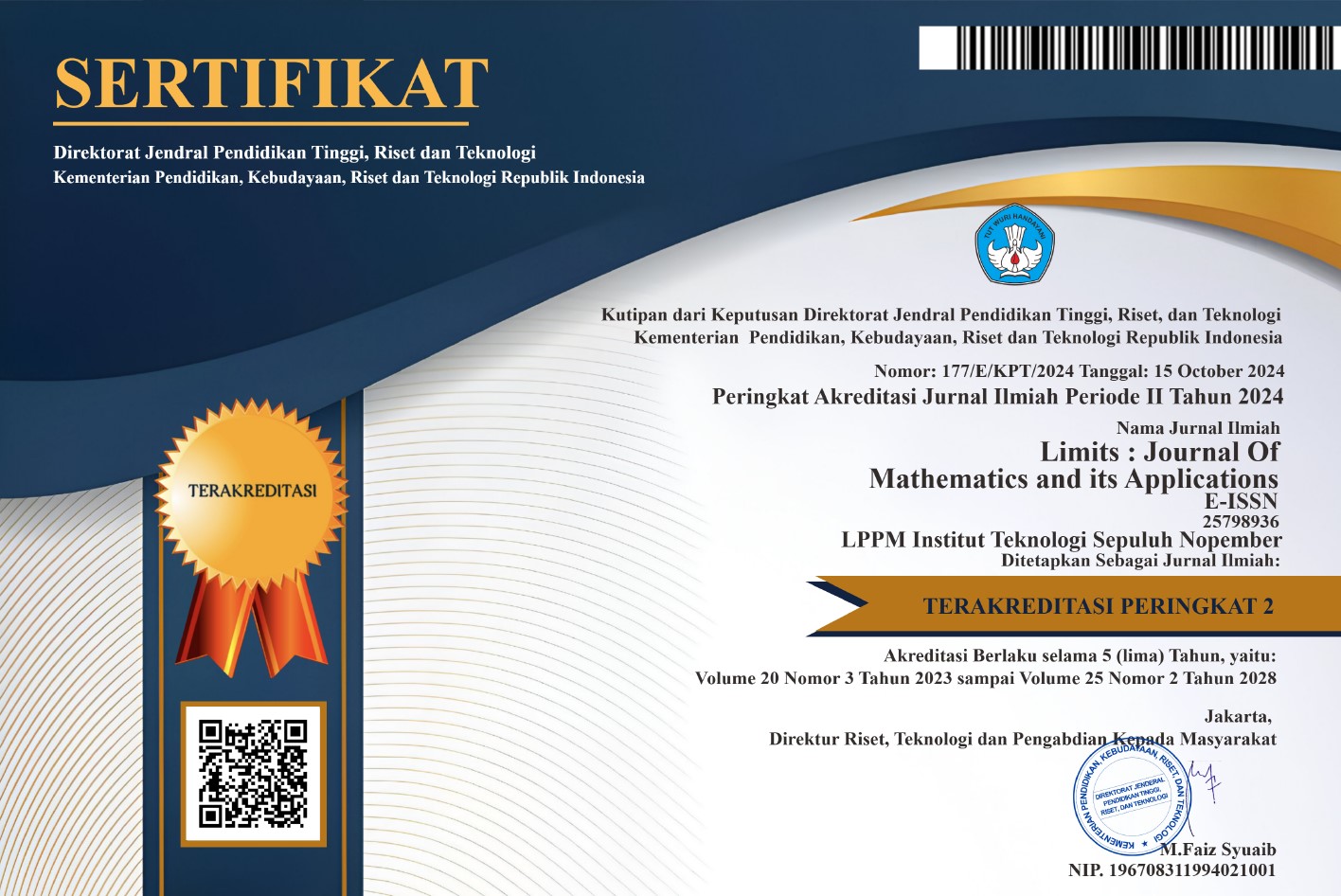Pemodelan Angka Harapan Hidup Negara G7 dengan Pendekatan Analisis Regresi Data Longitudinal
DOI:
https://doi.org/10.12962/limits.v22i1.3368Keywords:
Life Expectancy, Modelling, Generalized Least Square, G7 Countries, Good Health and Well-BeingAbstract
Life expectancy is the average number of years of life a newborn baby will live in a given year. In general, life expectancy is a tool to evaluate government performance in improving community welfare. The aim of this research is prediction using longitudinal data regression analysis methods, namely Generalized Least Square with a Restricted Maximum Likelihood approach using a uniform correlation structure, Autoregressive (AR) (1), and Gaussian with factors that influence life expectancy, namely Tax to GDP ratio, Gross Domestic Product per Capita (GDPPC) and Health Expenditure per Capita from 2000-2020 in G7 countries. Based on the analysis results, it was found that tax revenues had a negative effect of 0.155 but the effect was not significant, GDP had a positive effect of 0.715 but had a significant effect, while health expenditure had a negative effect of 0.49 on Life Expectancy. The research results found that conditions in the G7 that were not ideal caused negative effects on taxes and health spending that were not in accordance with theory. The suggestions that can be given include tax reform from the source and its implementation, such as cigarette tax and sugary drink tax. In addition, it also provides suggestions to include universal health for a healthier and more prosperous society. This research is also in accordance with the aim of Sustainable Development Goals (SDGs) number 3, namely "Ensuring healthy lives and improving the welfare of all populations of all ages" and can be used as a policy reference for Indonesia.
Downloads
References
World Health Organization, “Life Expectancy at Birth (Years),” Accessed: Oct. 05, 2024. [Online]. Available: https://www.who.int/data/gho/data/indicators/indicator-details/GHO/life-expectancy-at-birth-(years)
Badan Pusat Statistik Provinsi Sulawesi Barat, “Angka Harapan Hidup (AHH),” Accessed: Aug. 04, 2024. [Online]. Available: https://sulbar.bps.go.id/indicator/26/31/3/angka-harapan-hidup.html
A. V. Ardianti, S. Wibisono, and A. Jumiati, “Faktor-Faktor yang Mempengaruhi Angka Harapan Hidup di Kabupaten Jember,” 2014, Accessed: Aug. 04, 2024. [Online]. Available: https://repository.unej.ac.id/xmlui/handle/123456789/63942
N. Amalia and M. Mahmudah, “Faktor yang Mempengaruhi Angka Harapan Hidup di Provinsi Jawa Timur Tahun 2014 dengan Melihat Nilai Statistik Cp Mallows,” Jurnal Wiyata: Penelitian Sains dan Kesehatan, vol. 7, no. 1, Art. no. 1, Jan. 2020, doi: 10.56710/wiyata.v7i1.157.
O. A. Pradhipta and S. Harto, “Dampak Keikutsertaan Indonesia dalam Keanggotaan G20 Terhadap Hubungan Indonesia–Arab Saudi Tahun 2007–2011,” Jurnal Online Mahasiswa (JOM) Bidang Ilmu Sosial dan Ilmu Politik, vol. 1, no. 2, Art. no. 2, Aug. 2014.
Y. Saito, J. M. Robine, and E. M. Crimmins, “The Methods and Materials of Health Expectancy,” Stat J IAOS, vol. 30, no. 3, pp. 209–223, 2014, doi: 10.3233/SJI-140840.
Organisation for Economic Co-operation and Development, Health at a Glance 2023: OECD Indicators. Paris: Organisation for Economic Co-operation and Development, 2023. Accessed: Oct. 10, 2024. [Online]. Available: https://www.oecd-ilibrary.org/social-issues-migration-health/health-at-a-glance-2023_7a7afb35-en
D. A. Selian, “Pengaruh Pembiayaan Bank Syari’ah, Zakat, Produk Domestik Regional Bruto (PDRB) dan Inflasi terhadap Jumlah Penduduk Miskin di Sumatera Utara,” Jurnal As-Salam, vol. 1, no. 2, Art. no. 2, Dec. 2016.
Danardono, Analisis Data Longitudinal. Yogyakarta: Gadjah Mada University Press, 2018.
A. S. R, M. Hadijati, and N. W. Switrayni, “Analisis Masalah Heteroskedastisitas Menggunakan Generalized Least Square dalam Analisis Regresi,” EIGEN MATHEMATICS JOURNAL, pp. 61–72, Dec. 2019, doi: 10.29303/emj.v1i2.43.
D. N. Gujarati, Basic Econometrics, 4th Edition. New Delhi: Tata McGraw Hill, 2004.
F. Morina, A. Komoni, D. Kilaj, D. Selmonaj, and S. Grima, “The Effect of Health Expenditure on Life Expectancy,” International Journal of Sustainable Development and Planning, vol. 17, no. 5, pp. 1389–1401, 2022.
S. B. Zaman, N. Hossain, V. Mehta, S. Sharmin, and S. A. I. Mahmood, “An Association of Total Health Expenditure with GDP and Life Expectancy,” Journal of Medical Research and Innovation, vol. 1, no. 2, Art. no. 2, May 2017, doi: 10.15419/jmri.72.
N. Kontodimopoulos, “The Association Between Social Development And Population Health: A Cross-Sectional Study Across Countries Of Different Economic Growth,” Res Health Serv Reg, vol. 1, no. 1, p. 2, Jun. 2022, doi: 10.1007/s43999-022-00003-5.
World Bank, “World Bank Open Data,” Accessed: Oct. 10, 2024. [Online]. Available: https://data.worldbank.org
Organisation for Economic Co-operation and Development, Revenue Statistics 2023: Tax Revenue Buoyancy in OECD Countries. Paris: Organisation for Economic Co-operation and Development, 2023. Accessed: Oct. 10, 2024. [Online]. Available: https://www.oecd-ilibrary.org/taxation/revenue-statistics-2023_9d0453d5-en
N. C. Chamidah, Analisis Regresi Nonparametrik dengan Perangkat Lunak R. Airlangga University Press, 2023. Accessed: Oct. 25, 2023. [Online]. Available: https://omp.unair.ac.id/aup/catalog/book/888
E. D. Kartiningrum, H. B. Notobroto, B. W. Otok, N. E. Kumarijati, and E. Yuswatiningsih, Aplikasi Regresi dan Korelasi dalam Analisis Data Hasil Penelitian. STIKes Majapahit Mojokerto, 2022. Accessed: Oct. 03, 2024. [Online]. Available: https://repository.unair.ac.id/124805/
K. Kosmaryati, C. A. Handayani, R. N. Isfahani, and E. Widodo, “Faktor-Faktor yang Mempengaruhi Kriminalitas di Indonesia Tahun 2011-2016 dengan Regresi Data Panel,” Indonesian Journal of Applied Statistics, vol. 2, no. 1, Art. no. 1, Jul. 2019, doi: 10.13057/ijas.v2i1.27932.
N. U. Martaningtyas, E. A. Septiyaningrum, and Z. Maulana, “Dampak Pelanggaran Asumsi Klasik Terhadap Kesalahan Inferensi dalam Analisis Ekonometrika,” Synergy: Jurnal Ilmiah Multidisiplin, vol. 1, no. 04, Art. no. 04, 2024.
A. Lestari and Y. Setyawan, “Analisis Regresi Data Panel untuk Mengetahui Faktor yang Mempengaruhi Belanja Daerah di Provinsi Jawa Tengah,” Jurnal Statistika Industri dan Komputasi, vol. 2, no. 01, pp. 1–11, Jan. 2017, doi: 10.34151/statistika.v2i01.1092.
J. M. Wooldridge, Econometric Analysis of Cross Section and Panel Data. Cambridge: MIT Press, 2002.
A. C. Rencher and G. B. Schaalje, Linear Models in Statistics. Hoboken: John Wiley & Sons, 2008.
P. Diggle and P. J. Ribeiro, Model-based Geostatistics. Berlin: Springer, 2007.
E. A. Ebrahim, M. A. Cengiz, and E. Terzi, “The Best Fit Bayesian Hierarchical Generalized Linear Model Selection Using Information Complexity Criteria in the MCMC Approach,” Journal of Mathematics, vol. 2024, no. 1, p. 1459524, 2024, doi: https://doi.org/10.1155/2024/1459524
R. Rameez, S. Jahageerdar, J. Jayaraman, T. I. Chanu, R. Bangera, and A. Gilmour, “Evaluation of Alternative Methods for Estimating the Precision of REML-based Estimates of Variance Components and Heritability,” Heredity, vol. 128, no. 4, p. 197, Feb. 2022, doi: https://doi.org/10.1038/s41437-022-00509-1
M. Roser, “Why is Life Expectancy in the US Lower than in Other Rich Countries?,” Our World in Data, Mar. 2024, Accessed: Oct. 10, 2024. [Online]. Available: https://ourworldindata.org/us-life-expectancy-low
X. Xiong, “Bring Technology Home & Stay Healthy: the Role of 4th Industrial Revolution & Technology in Improving the Efficacy of Health Care Spending,” Technological Forecasting and Social Change, vol. 165, no. C, 2021, Accessed: Aug. 04, 2024. [Online]. Available: https://ideas.repec.org//a/eee/tefoso/v165y2021ics0040162520313822.html
A. Baum, S. A. Gomez, J. Lightwood, E. Bruzelius, S. A. Glantz, and S. Basu, “Estimating the Long-Run Relationship between State Cigarette Taxes and County Life Expectancy,” Tobacco Control, vol. 29, no. 1, pp. 81–88, Jan. 2020, doi: https://doi.org/10.1136/tobaccocontrol-2018-054686
Organisation for Economic Co-operation and Development, Health at a Glance 2021: OECD Indicators. Paris: Organisation for Economic Co-operation and Development, 2021. doi: https://doi.org/10.1787/ae3016b9-en
M. W. Long, S. L. Gortmaker, Z. J. Ward, S. C. Resch, M. L. Moodie, G. Sacks, B. A. Swinburn, R. C. Carter, and Y. C. Wang, “Cost Effectiveness of a Sugar-Sweetened Beverage Excise Tax in the U.S.,” Am J Prev Med, vol. 49, no. 1, pp. 112–123, Jul. 2015, doi: https://doi.org/10.1016/j.amepre.2015.03.004
B. Seligman, G. Greenberg, and S. Tuljapurkar, “Equity and Length of Lifespan are Not the Same,” Proceedings of the National Academy of Sciences, vol. 113, no. 30, pp. 8420–8423, Jul. 2016, doi: https://doi.org/10.1073/pnas.1601112113
S. Grima, “Commentary: Comparison of Historical Medical Spending Patterns Among the BRICS and G7,” Frontiers in Pharmacology, Jan. 2016, Accessed: Aug. 04, 2024. [Online]. Available: https://www.academia.edu/97541493/Commentary_Comparison_of_historical_medical_spending_patterns_among_the_BRICS_and_G7





